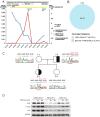NF-κB1 Haploinsufficiency Causing Immunodeficiency and EBV-Driven Lymphoproliferation
- PMID: 27338827
- PMCID: PMC4940442
- DOI: 10.1007/s10875-016-0306-1
NF-κB1 Haploinsufficiency Causing Immunodeficiency and EBV-Driven Lymphoproliferation
Abstract
Purpose: NF-κB signaling is critically important for regulation of both innate and adaptive immune responses. While activation of NF-κB has been implicated in malignancies such as leukemia and lymphoma, loss-of-function mutations affecting different NF-κB pathway components have been shown to cause primary immunodeficiency disorders. Recently, haploinsufficiency of NF-κB1 has been described in three families with common variable immunodeficiency (CVID).
Methods and results: We studied a patient with recurrent respiratory infections and bacterial parapharyngeal abscess. Immunological investigations revealed normal total B- cell numbers, but hypogammaglobulinemia, decreased frequencies of class-switched B cells and impaired T-cell proliferation. Targeted next-generation sequencing using a custom-designed panel comprising all known PID genes (IUIS 2014 classification) and novel candidate genes identified a novel heterozygous frameshift mutation in the NFKB1 gene leading to a premature stop codon (c.491delG; p.G165A*31). We could show that the mutation leads to reduced phosphorylation of p105 upon stimulation, resulting in decreased protein levels of p50. The further disease course was mainly characterized by two episodes of severe EBV-associated lymphoproliferative disease responsive to rituximab treatment. Due to disease severity, the patient is considered for allogeneic hematopoietic stem cell transplantation. Interestingly, the father carries the same heterozygous NFKB1 mutation and also shows decreased frequencies of memory B cells but has a much milder clinical phenotype, in line with a considerable phenotypic disease heterogeneity.
Conclusions: Deficiency of NF-κB1 leads to immunodeficiency with a wider phenotypic spectrum of disease manifestation than previously appreciated, including EBV lymphoproliferative diseases as a hitherto unrecognized feature of the disease.
Keywords: Combined immunodeficiency; EBV lymphoproliferative disease; NF-κB1; haploinsufficiency.
Figures


Comment in
-
The Expanding Spectrum of NFkB1 Deficiency.J Clin Immunol. 2016 Aug;36(6):531-2. doi: 10.1007/s10875-016-0310-5. Epub 2016 Jun 23. J Clin Immunol. 2016. PMID: 27338826 No abstract available.
References
Publication types
MeSH terms
Substances
Grants and funding
LinkOut - more resources
Full Text Sources
Other Literature Sources
Research Materials
Miscellaneous

